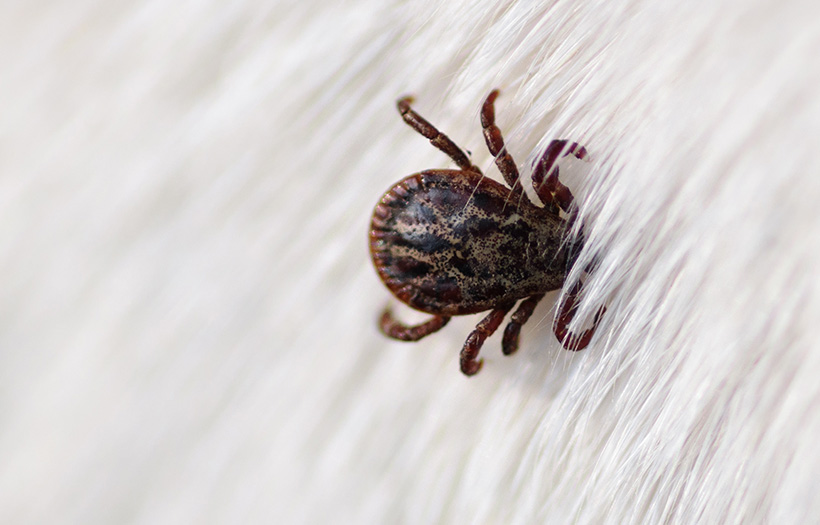Tick Talk

It seems we hear more and more about the danger of ticks every year and the havoc they wreak on humans and pets alike.
Ticks are not insects. Having eight legs, they are arachnids, more closely related to scorpions and spiders than insects. Ticks are ectoparasites (parasites that live on the outside of its host) and live by feeding on the blood of mammals, birds and occasionally reptiles and amphibians.
Lifecycle of a Tick
Ticks have a four-stage lifecycle. They begin as eggs in a cool, moist environment. The eggs hatch into six-legged larva that congregate in groups around vegetation and wait for a small rodent or other host to pass by. After a blood meal, the larva drops onto the ground and molts into an eight-legged nymph. The nymph also waits for a host, takes a blood meal and drops off onto the ground to molt into the final adult stage. Adult ticks seek out a third host, take a blood meal, mate, and drop off to lay 3000 to 6000 eggs, and the cycle starts over again. For the Blacklegged or Deer tick (Ixodes scapularis), this cycle takes about two years. Although ticks prefer moist environments and dry out in the sun, they are very hearty in cold weather. Adult Deer ticks are not killed by freezing temperatures and will be active any winter day when ground is not frozen or snow covered.
Controlling these pesky critters is important because they carry disease organisms that can affect us and our pets. These include Lyme disease, Ehrlichia, Anaplasma, Babesia, and possibly Bartonella, the causative organism of some chronic inflammatory diseases in cats and Cat Scratch Fever in people. We can only prevent one of these diseases by vaccination, Lyme disease. For Lyme disease, vaccination is only considered a secondary method of control. The primary method is tick control, therefore it is important to have a good tick control program in place.
Tick Control and Prevention
Tick prevention is about controlling ticks on your pet and in their environment. There are many tick control products on the market for pets. They come in topical or oral products or as collars. Most of these products do not repel ticks but will kill them within 24 hours of attaching to your pet. This is important because ticks need to feed for at least 24 hours before they can transmit Lyme disease to your dog. However, some diseases such as Anaplasma can be transmitted in a matter of a few hours of feeding, so it is important to also control ticks in the environment before they can attach to your pet.
Controlling the outdoor environment is more difficult. From the tick lifecycle, we know that they need a cool, damp environment to develop from one stage to the next or they will dry out and die. Much like vampires of the classic Hollywood movies, sunlight is their enemy. Consider these options to keep ticks out of your yard.
- Keep your lawn cut short so ticks have no protection from the sun.
- Fence off shade producing ornamental shrubs around the house and shaded areas under porches and decks.
- Cut unnecessary or low hanging branches on larger trees to allow the sunlight in.
- Walk your dog at least 3 feet from the edge of the woods or brush. Shade-loving ticks will usually not venture more than 3 feet from the edge of the woods into sunny areas.
- If you need to use an acaricide on your lawn, read the label carefully to be certain it is safe for your pets. Remember this is a temporary solution since most outdoor treatments will give you a quick knock down but will not last very long due to degradation from sunlight or being washed away by rain. Squirrels, chipmunks and other rodents can also bring ticks back into your home environment after treatment.
Cats and Ticks
When we talk about tick diseases, we generally think about dogs being at risk, but cats are susceptible to tick borne diseases as well. Cats can contract Cytauxzoonosis, Tularemia, Haemobartonella, Babesia, Ehrlichia, and possibly Bartonella from ticks. These diseases can be severe, requiring hospitalization and in some patients, may even be fatal. Cats are particularly sensitive to some of the tick control products used on dogs. Never use a product intended for a dog on cats, it can be potentially fatal. Read the label carefully and only use feline safe products.
How to Safely Remove Ticks
If you find a tick attached to your pet, it should be removed immediately. Using a pair of tweezers or a commercial tick remover (O’Tom Tick Remover®, Tick Twister®), grasp the tick head near the skin and use gentile traction to remove, or “unscrew” the tick by rotating counter clockwise. Try not to squeeze the tick’s body as this may expel disease causing organisms into the bite wound. Folklore remedies like touching the tick with a hot match or smothering it with Vaseline® or mineral oil are not recommended, as these remedies may also cause the tick to vomit into the bite wound as it dies. Also do not handle the tick with ungloved hands as disease causing organisms can gain access through open wounds or cracks in your skin.
As always, questions about the benefits and use of specific tick control products should be discussed with your veterinarian.
